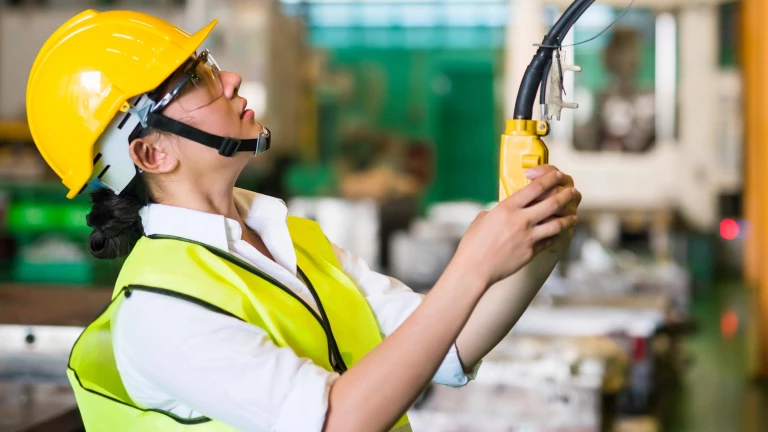A global survey of 16,600 industrial sector employees reveals changing attitudes about work, what’s important on the job, and the training needed to stay ahead.
This article is part of BCG’s Decoding Global Talent series, which investigates how work gets done around the world to uncover long-term workforce trends.
Industrial goods companies are under pressure. Along with continuing their digital transformations to modernize and operating more sustainably to address climate issues, they face a raft of workforce issues. Employee expectations shifted because of the pandemic. At the same time, people’s interest in relocating for work declined and competition for new hires with in-demand skills increased.
But the situation isn’t all bad. Blue- and white-collar workers in the sector are eager to learn new skills that would open the door to new opportunities. Many are keen to work for organizations that share their beliefs about social issues and the environment.
These and other insights come from a worldwide survey of approximately 16,600 employees working in more than 20 different job categories at industrial goods companies. They were among the 209,000 people in 190 countries polled by BCG and The Network, a global alliance of recruitment websites, for the ongoing Decoding Global Talent series.
A Workforce Hit Hard by the Pandemic
More employees of industrial goods companies lost jobs or had their work hours cut during the COVID-19 crisis than in almost any other industry we studied except for travel and tourism, media, and professional services. The most effected were manual laborers in such industries as manufacturing, mining, agriculture, and logistics. More than one in five (21%) were laid off, and another 20% had their hours cut. Among knowledge workers in the industry, 14% were laid off and 17% had their hours cut.
The pandemic has a direct effect on employees’ feelings about work, as indicated by key measures of workplace sentiment. Feelings about their own well-being, work-life balance, and effectiveness declined. Satisfaction with the quality and style of their organizations’ leadership and with team collaboration also fell significantly.
A Massive Shift in Work Preferences
Industrial goods employees adapted to new ways of working during the pandemic and want to retain flexibility over where and when they work. More than half (55%) of the industry’s knowledge workers now want to work remotely two or three days a week. In addition, 70% of frontline workers would prefer to work remotely at least some of the time, though the reality of offering such an arrangement could vary widely by industry and role.
The pandemic also changed the aspects of work that industrial goods worker value the most. Maintaining good work relationships and a good work-life balance became more important. Maintaining a solid relationship with a superior also increased in importance during the pandemic for workers of all types.
Interest in Virtual International Jobs Increases
Interest in remote work led 55% of industrial goods workers to say they would consider working virtually for an employer based in a different country or region, and in particular for organizations headquartered in Germany, the US, Australia, and Canada.
Fewer employees are keen to physically move to a different region for a work opportunity, continuing a decline we’ve tracked since our first global talent survey, in 2014. Just 50% of the industrial goods workforce was willing to move abroad for work in 2020, compared with 67% in 2014. Germany is the top destination for an overseas assignment for industrial goods workers, and other top locations include Canada, the US, Australia, and Japan.
Industrial Workers Are Eager to Learn
Industrial goods workers are fearful of the increased threat that automation poses to their livelihoods and are willing to reskill or upskill as a result. Of the total workforce, 45% of frontline workers and 39% of knowledge workers said that the issue of having their jobs automated or replaced by robotics became more important in the past year. And 69% are willing to retrain, slightly higher than the average for jobs across all industries.
Early- and mid-career employees are more willing than most to reskill, possibly because they have more years left on the job than older workers during which they could put new skills to use. Industrial goods employees in Africa and the Middle East are more willing to spend time learning new skills than respondents from Europe and America.
Sixty percent of industrial goods workers average at least a few weeks a year to training. Only 56% of blue-collar workers in the industry spend that amount of time a year on training, the lowest portion for any industry we surveyed. The low participation in training could potentially be the result of industrial goods companies focusing their training on health, safety, and environmental issues rather than upskilling.
When they learn new skills for their existing position or reskill for a new one, industrial goods workers want to learn online, a common trend across all the industries we studied.
Five Ways to Attract and Retain the Industrial Goods Workforce
Industrial goods companies accelerated their transition to digital during the pandemic to accommodate new ways of working. Now they must figure out how to make the changes permanent in a way that works for both the business and a divergent workforce. Among other things, they can:
- Develop a strategic workforce plan.
- Provide flexibility in a way that works for employees of all types as well as the business, including rethinking shift-work schedules for blue-collar workers.
- Consider new workforce sources, including recruiting people who would be willing to work remotely from a different region.
- Cultivate an environment that contributes to good relationships between supervisors and their direct reports and among coworkers, two aspects of work that we know are important to both knowledge workers and frontline personnel.
- Offer opportunities for people to pick up new skills in areas the organization needs in order to prosper, and do so in ways that they prefer to learn, such as through online classes and by integrating learning into daily work.
Industrial goods companies must consider what their workers feel and say about work and use those insights to strengthen their value proposition. Changes could entail creating strategies for two different employee groups, which could result in policies that are more complex than in the past. But that could be what it takes to hang on to valued workers and attract talent in the future.






